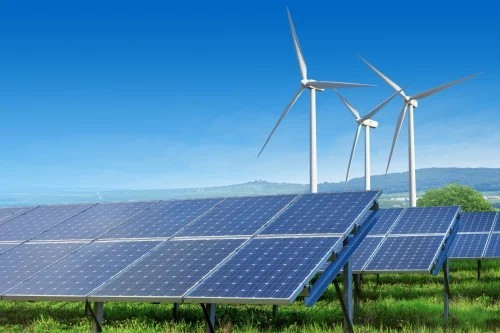Impact of U.S. Tariffs on Solar Energy Growth
Impact of U.S. Tariffs on Solar Energy Growth
Syllabus:
GS-2:
Effect of Policies & Politics of Countries on India’s Interests , International Treaties & Agreements , Government Policies & Interventions , India and its Neighbourhood , Important International Institutions
Focus:
The U.S. has imposed high tariffs on solar panels and cells from various countries, including Vietnam, China, and Cambodia. These tariffs threaten the growth of solar energy by making it less cost-competitive with fossil fuels, hampering the country’s transition to renewable energy.
Introduction: U.S. Tariffs on Solar Imports – A Regressive Climate Policy
New Tariffs and Their Scope
- Recently, the U.S. imposed extraordinarily high tariffs on imported solar panels.
- Countries like Vietnam (46%) and China (145%) are heavily impacted.
- Tariffs on solar modules from Cambodia reach a staggering 3,521%.
- About 80% of U.S. solar panel imports are now subject to restrictive duties.
Context: Escalating Trade Protectionism
- The move builds on Donald Trump’s “America First” trade agenda
- The Biden administration has continued elements of Trump’s protectionism.
- These tariff hikes are described as more than trade measures—they are climate policy setbacks.
Impact on Solar Energy Sector:
Solar’s Dominance in New Energy Capacity
- In 2023, two-thirds of new power capacity in the U.S. came from solar installations.
- Solar energy, often bundled with battery storage, has led the clean energy transition.
- The cost advantages of solar made it the preferred option for utilities planning new power plants.
Tariffs Undermine U.S. Solar Supply Chain
- New tariffs apply not just to modules but also to solar cells, the building blocks of panels.
- The U.S. has limited to no domestic production capacity for solar cells.
- Without foreign imports, developers will face:
- Higher equipment costs,
- Delays due to supply shortages,
- Or cancellation of planned solar projects.
Stunted Growth and Stagnant Costs
- Over the past 5 years, U.S. solar project costs have remained flat.
- In contrast, solar installation costs have dropped significantly (by around 60%) in countries like:
- China, Germany, India, Japan, and the UK.
- In 2023, U.S. solar power was 24% more expensive than gas-based electricity, while it was far cheaper elsewhere.
Broader Economic and Environmental Implications:
Disadvantaging Renewable Energy
- About 30% of a utility-scale solar project’s cost in the U.S. goes toward buying panels.
- Raising panel prices erodes solar’s price competitiveness with fossil fuels.
- With rising tariffs and potential rollback of Biden-era subsidies, renewables lose their edge.
Re-tilting Towards Fossil Fuels
- Morgan Stanley reports that even a 10% tariff could make gas-fired power plants more appealing.
- The new triple-digit tariffs heavily tilt the playing field toward natural gas and coal.
- Fossil fuels now enter the U.S. tariff-free, while renewables face punitive taxation.
Undoing Climate Gains
- These policies risk pushing the U.S. back to an era when renewables couldn’t compete
- Solar once needed minimal backup storage; today’s solar-with-batteries can rival gas—but only with global-price equipment.
- Tariffs on battery imports (e.g., 145% on China, 24-25% on Japan and South Korea) further hurt clean energy economics.
Strategic and Global Consequences:
Falling Behind Global Peers
- The European Union installed 39% more solar capacity than the U.S. over the past five years.
- This occurred despite less favorable sunlight conditions in Europe.
- Industry forecasts suggest the EU will continue to outpace the U.S., worsening America’s clean energy lag.
Supply Chain Isolation
- Years of bipartisan protectionism have weakened U.S. solar manufacturing.
- Building domestic supply chains, especially for solar cells and batteries, takes years and billions in investment.
- In the interim, punitive tariffs are disrupting supply, halting projects, and delaying transition goals.
Policy Contradictions
- The U.S. declared a “national energy emergency” under Trump to justify such tariffs.
- Ironically, fossil fuels face no such emergency-level barriers and continue to enjoy free trade access.
- This selectively burdens clean energy with artificial costs, while fossil fuels flourish under protection.
Way Forward: Balancing Trade and Climate Goals
Reform Trade Policy for Climate Alignment
- Future U.S. administrations must align trade policy with climate objectives, not against them.
- Tariffs should encourage domestic clean tech while maintaining access to global supply chains until self-sufficiency is achieved.
Boost Domestic Manufacturing Strategically
- Rather than blanket tariffs, the U.S. should:
- Offer production-linked incentives for solar cell factories.
- Fund R&D and innovation in renewable technologies.
- Improve workforce development for green jobs.
Ensure Long-term Competitiveness
- Renewable energy will win globally where market forces are free.
- But in a distorted market with trade barriers and subsidies favoring fossil fuels, the clean energy transition risks derailment.
- A balanced approach—combining tariff rationalization, domestic capacity building, and subsidy reform—is essential for U.S. climate leadership.
Conclusion:
The new U.S. tariffs undermine the competitiveness of solar energy, slowing the country’s shift to cleaner energy sources. These protectionist policies risk delaying climate goals and worsening the energy crisis by favoring fossil fuels. A strategic revision of trade policies is needed to support renewable energy and climate leadership.
Source: Mint
Mains Practice Question:
Analyze the economic and environmental implications of the U.S. tariffs on solar panel imports. How do these tariffs affect the country’s renewable energy transition and global leadership in climate action?





